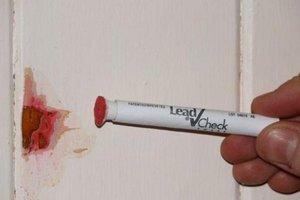Making RRP Easier - New Understandings About RRP Work Practices

Guest Blogger: Dean Lovvorn is a residential remodeler who has done numerous RRP projects. He is also a Lead Inspector, Lead Risk Assessor and EPA RRP Renovator Instructor.
This blog post is a follow-up to a previous RRPedia Guest Blog where Dean listed several differences between the work practices taught in the required Certified Renovator class and what he found is actually required in the RRP rule.
Making RRP Easier - New Understandings About RRP Work Practices

Back in April 2010, I had an exterior remodeling job that was put on hold for a day because of heavy rains. In my boredom, I decided to read the actual RRP law from start to finish. I soon discovered that what I was taught in my 8 hour class and what was in the student manual wasn’t necessarily in the actual law itself.
I was probably dozing off in the 8 hour renovator class, but after these discoveries, I began to clarify some new understandings.
- On exterior containment set-ups, all I really needed to do was put plastic on the ground, be sure windows & doors were closed, cover any doors within 20 feet with plastic and put out a warning sign. If there are no doors and/or windows within 20 feet, simply put plastic on the ground and a warning sign up. Nothing else needed.
- On interior containment set-ups, I just needed to do the same as the exterior (except 6 feet out from where I was working). If there were no furniture/objects or ducts within the 6 foot area … I didn’t have to go any further. Be sure to tape down the plastic on the floor.
Of course, if I was doing some really dusty work, I made the containment (work area) larger, but other than that, it was pretty quick, easy and simple if you were to ask me.
Following are some examples of how reading the actual law has helped me.
Siding Replacement
 In this example, I would place 3.5 mil plastic (from Home Depot), instead of the 6 mil plastic 10 feet out on the ground. Then, I would make sure doors/windows were closed, put plastic over any doors and then put up the warning sign. I would also run a plastic runner out to the dumpster and surround the ground around the dumpster with plastic. Doing the containment this way, saves me from having to wrap, bag or HEPA vac the siding (or myself). This is because I can dump the siding without ever going outside the containment area.
In this example, I would place 3.5 mil plastic (from Home Depot), instead of the 6 mil plastic 10 feet out on the ground. Then, I would make sure doors/windows were closed, put plastic over any doors and then put up the warning sign. I would also run a plastic runner out to the dumpster and surround the ground around the dumpster with plastic. Doing the containment this way, saves me from having to wrap, bag or HEPA vac the siding (or myself). This is because I can dump the siding without ever going outside the containment area.
If exterior vertical containment is needed a simple solution (pictured to right) can be done.
Replacing Door Slabs
If my job is to replace 15 door slabs, I simply do this without following RRP. This is because the only area I am disturbing on each door is the hinge area and since it falls under the Minor Repair and Maintenance Activities, RRP is not required. This insight came from the FAQ section of the EPA web site.
Bathroom Remodel (Total Gut)
 I can demo the tile, tub, shower, toilet and remove the demolition debris without doing any RRP. After that has been done, I cover up ducts with plastic, make sure windows are closed, close doors and cover with plastic, put up a warning sign and then cover the subfloor with plastic (6 feet out from where I will be working).
I can demo the tile, tub, shower, toilet and remove the demolition debris without doing any RRP. After that has been done, I cover up ducts with plastic, make sure windows are closed, close doors and cover with plastic, put up a warning sign and then cover the subfloor with plastic (6 feet out from where I will be working).
I put the demoed walls, cabinets and trim into trash cans (with lids on top) and HEPA vac the outside of the trash cans (along with myself) before taking them out of the containment area.
Note: If I’m lucky and there is an exit door (to the outside) close by … I could run plastic to the door, then outside to the dumpster. This way, I wouldn’t need to worry about containing the demolition debris.
Normally, I do the final clean-up, visual inspection and cleaning verification after demolition; so that I can officially end RRP and let non-certified electricians/plumbers/sub-contractors into the work area.
Conclusion
 It very well could be that if you did a little homework by reading the actual law, you could reduce the cost of compliance on many jobs to less than 5%. Few contractors will lose a job because they are higher by less than 5%. Plus, with the cost less than 5%, I don’t even mention RRP to my clients during the estimation process anymore, which has helped to improve sales.
It very well could be that if you did a little homework by reading the actual law, you could reduce the cost of compliance on many jobs to less than 5%. Few contractors will lose a job because they are higher by less than 5%. Plus, with the cost less than 5%, I don’t even mention RRP to my clients during the estimation process anymore, which has helped to improve sales.




 Looking for accurate information about the EPA RRP rule?
Looking for accurate information about the EPA RRP rule? 

 Containment is required by the RRP Rule because it reduces the risk to you and residents. Following the work area setup requirements will protect you, your co-workers and residents by confining lead-contained dust and debris to a defined and demarcated area. Confining the lead is an important consideration in avoiding exposure. Reducing the risk to you and co-workers is also dependent upon use of personal protective equipment. Requirements for the personal protection of workers are established by OSHA and can be found in the OSHA document titled
Containment is required by the RRP Rule because it reduces the risk to you and residents. Following the work area setup requirements will protect you, your co-workers and residents by confining lead-contained dust and debris to a defined and demarcated area. Confining the lead is an important consideration in avoiding exposure. Reducing the risk to you and co-workers is also dependent upon use of personal protective equipment. Requirements for the personal protection of workers are established by OSHA and can be found in the OSHA document titled  Proper containment also facilitates efficient cleaning of the work area. The pre-work setup process is essential to keeping lead-contaminated dust confined to the work area where it can be easily cleaned. Proper containment of the work area helps to limit the area you need to clean after the job is complete. Knowing exactly where to clean is an important factor in saving time (and money) spent on cleanup.
Proper containment also facilitates efficient cleaning of the work area. The pre-work setup process is essential to keeping lead-contaminated dust confined to the work area where it can be easily cleaned. Proper containment of the work area helps to limit the area you need to clean after the job is complete. Knowing exactly where to clean is an important factor in saving time (and money) spent on cleanup.  Covering floors (or the ground) with plastic sheeting a minimum distance beyond the surfaces being renovated (6 feet for interior jobs and 10 feet for exterior jobs).
Covering floors (or the ground) with plastic sheeting a minimum distance beyond the surfaces being renovated (6 feet for interior jobs and 10 feet for exterior jobs).

 In this example, I would place 3.5 mil plastic (from Home Depot), instead of the 6 mil plastic 10 feet out on the ground. Then, I would make sure doors/windows were closed, put plastic over any doors and then put up the warning sign. I would also run a plastic runner out to the dumpster and surround the ground around the dumpster with plastic. Doing the containment this way, saves me from having to wrap, bag or HEPA vac the siding (or myself). This is because I can dump the siding without ever going outside the containment area.
In this example, I would place 3.5 mil plastic (from Home Depot), instead of the 6 mil plastic 10 feet out on the ground. Then, I would make sure doors/windows were closed, put plastic over any doors and then put up the warning sign. I would also run a plastic runner out to the dumpster and surround the ground around the dumpster with plastic. Doing the containment this way, saves me from having to wrap, bag or HEPA vac the siding (or myself). This is because I can dump the siding without ever going outside the containment area. I can demo the tile, tub, shower, toilet and remove the demolition debris without doing any RRP. After that has been done, I cover up ducts with plastic, make sure windows are closed, close doors and cover with plastic, put up a warning sign and then cover the subfloor with plastic (6 feet out from where I will be working).
I can demo the tile, tub, shower, toilet and remove the demolition debris without doing any RRP. After that has been done, I cover up ducts with plastic, make sure windows are closed, close doors and cover with plastic, put up a warning sign and then cover the subfloor with plastic (6 feet out from where I will be working).  It very well could be that if you did a little homework by reading the actual law, you could reduce the cost of compliance on many jobs to less than 5%. Few contractors will lose a job because they are higher by less than 5%. Plus, with the cost less than 5%, I don’t even mention RRP to my clients during the estimation process anymore, which has helped to improve sales.
It very well could be that if you did a little homework by reading the actual law, you could reduce the cost of compliance on many jobs to less than 5%. Few contractors will lose a job because they are higher by less than 5%. Plus, with the cost less than 5%, I don’t even mention RRP to my clients during the estimation process anymore, which has helped to improve sales. 
 The first thing you should consider is that all bills introduced must first go to committee. The second thing you should realize is that the vast majority of bills introduced … will never get out of committee review and thus, will never get a chance to be voted on. Thirdly, even if the bill gets voted on, it must be approved by the majority of Senators (in this bill’s case). Lastly, even if passed by the Senate; the House & President must approve.
The first thing you should consider is that all bills introduced must first go to committee. The second thing you should realize is that the vast majority of bills introduced … will never get out of committee review and thus, will never get a chance to be voted on. Thirdly, even if the bill gets voted on, it must be approved by the majority of Senators (in this bill’s case). Lastly, even if passed by the Senate; the House & President must approve. The grandparent of RRP is Title X of the Housing and Community Development Act of 1992, also known as the Residential Lead-Based Paint Hazard Reduction Act of 1992 (Title X). The grandparents gave birth to the parent of RRP, Title IV—Lead Exposure Reduction, which amended the Toxic Substances Control Act (TSCA).
The grandparent of RRP is Title X of the Housing and Community Development Act of 1992, also known as the Residential Lead-Based Paint Hazard Reduction Act of 1992 (Title X). The grandparents gave birth to the parent of RRP, Title IV—Lead Exposure Reduction, which amended the Toxic Substances Control Act (TSCA). To put it simply, we need to come to grips that the RRP is most likely going to be required on public and commercial buildings. Public and commercial buildings have adults in them. Would it make sense to Opt-Out adults in target homes, but not Opt-Out adults in public and commercial buildings? Unfortunately, the answer is most likely not.
To put it simply, we need to come to grips that the RRP is most likely going to be required on public and commercial buildings. Public and commercial buildings have adults in them. Would it make sense to Opt-Out adults in target homes, but not Opt-Out adults in public and commercial buildings? Unfortunately, the answer is most likely not.

 There was no mention of having to wear disposable suits, dust mask, booties or headwear. (Still might need to comply with OSHA)
There was no mention of having to wear disposable suits, dust mask, booties or headwear. (Still might need to comply with OSHA) It didn’t say I had to use 6 mil plastic, which made me happy since the 3.5 mil plastic sold at Home Depot cost less.
It didn’t say I had to use 6 mil plastic, which made me happy since the 3.5 mil plastic sold at Home Depot cost less.


 A recent survey by the National Association of the Remodeling Industry shows that a full majority of members responding to the survey agreed with the
A recent survey by the National Association of the Remodeling Industry shows that a full majority of members responding to the survey agreed with the  The NARI press release also clarified that NARI continues to work actively with the EPA on ways the agency can educate the public on the importance of hiring EPA-certified remodelers to do work on homes built before 1978. NARI has been and continues to push the agency for tougher enforcement of the rules to crack down on firms lacking the required EPA certification that are violating the rule and failing to protect homeowners.
The NARI press release also clarified that NARI continues to work actively with the EPA on ways the agency can educate the public on the importance of hiring EPA-certified remodelers to do work on homes built before 1978. NARI has been and continues to push the agency for tougher enforcement of the rules to crack down on firms lacking the required EPA certification that are violating the rule and failing to protect homeowners.
 I suggest the real problem is that the original rule was poorly conceived and poorly written. Because we are now stuck with it, the proposed amendments are really just band-aid approaches to try to make it better for or more palatable to those affected by the rule. What we really need is a new well thought out rule to replace the existing rule, with the input and leadership of the industry this time. And, the industry needs to be proactive this time in its writing, its content and its enforcement.
I suggest the real problem is that the original rule was poorly conceived and poorly written. Because we are now stuck with it, the proposed amendments are really just band-aid approaches to try to make it better for or more palatable to those affected by the rule. What we really need is a new well thought out rule to replace the existing rule, with the input and leadership of the industry this time. And, the industry needs to be proactive this time in its writing, its content and its enforcement. Not using lead safe practices on a pre 1978 property is a big risk. Unless the house is pretested before renovations there is no point of reference regarding existing contamination. If lead safe work practices are not used, how will the business prove it did not cause the contamination?
Not using lead safe practices on a pre 1978 property is a big risk. Unless the house is pretested before renovations there is no point of reference regarding existing contamination. If lead safe work practices are not used, how will the business prove it did not cause the contamination?
 Legislation introduced by Senator Inhofe (R) will soon be before the US Senate for consideration. Inhofe introduced Bill 2148, the
Legislation introduced by Senator Inhofe (R) will soon be before the US Senate for consideration. Inhofe introduced Bill 2148, the  Unfortunately we are stuck with the RRP Rule. Maybe the best we can do is try to improve upon it.
Unfortunately we are stuck with the RRP Rule. Maybe the best we can do is try to improve upon it. This one requires EPA to actually use science to justify its position regarding any future RRP related regulations related to residential as well as commercial properties:
This one requires EPA to actually use science to justify its position regarding any future RRP related regulations related to residential as well as commercial properties:
 Both sides of this issue have valid points to consider. Before we make rash decisions have we looked at the entire picture? We can do better than our politicians, but we must think before we act.
Both sides of this issue have valid points to consider. Before we make rash decisions have we looked at the entire picture? We can do better than our politicians, but we must think before we act. Whether the Opt Out comes back or not, what about the employees of the firms who intend on using this option? Did anyone ask those who are actually doing the work how they feel about their health risks? Will they have a voice without retaliation?
Whether the Opt Out comes back or not, what about the employees of the firms who intend on using this option? Did anyone ask those who are actually doing the work how they feel about their health risks? Will they have a voice without retaliation? I believe this law can create marketing and positioning opportunities to those who see it this way and in the process, keeps everyone safe – and for those who see it differently, it’s obviously a never ending source of complaints which has divided our industry at a time when we need each others’ back more than ever.
I believe this law can create marketing and positioning opportunities to those who see it this way and in the process, keeps everyone safe – and for those who see it differently, it’s obviously a never ending source of complaints which has divided our industry at a time when we need each others’ back more than ever.


